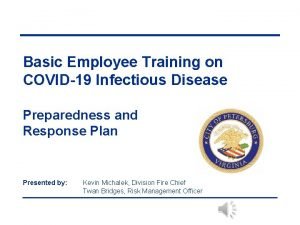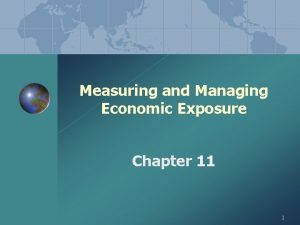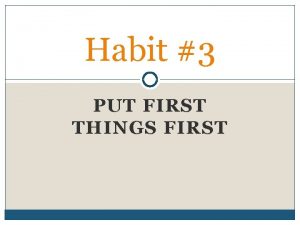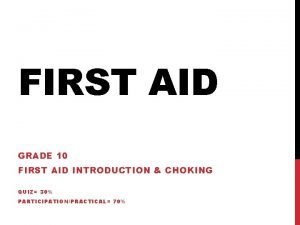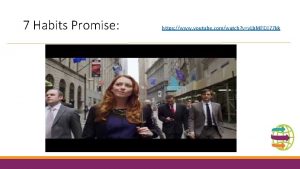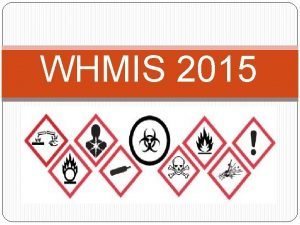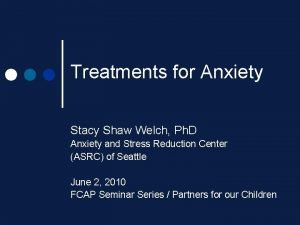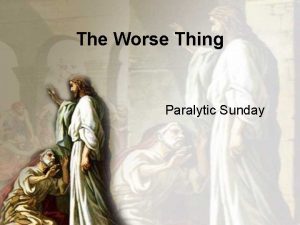Overview Economic exposure to COVID19 First thing Im










































- Slides: 42

Overview Economic exposure to COVID-19 § First thing I’m talking about (capital letter at the start) § Second Potential thing local vulnerabilities across Great Britain – this is a particularly interesting part of the second thing (no capital letter) o and this… § Third thing Chris Thoung, Anja Heimann and Matthew Haynes 2 June 2020

Last updated: 02/06/2020 Introduction Version history 02/06/2020 Added new analysis of occupations and comparison with sector-based projections from the UK OBR. 28/04/2020 First version of the briefing. The top-right corner of each content slide gives the last modified date.

Last updated: 02/06/2020 Considerations

Last updated: 28/04/2020 Focus on sectors

Last updated: 02/06/2020 Focus on occupations

Last updated: 02/06/2020 Focus on small businesses

Last updated: 02/06/2020 Focus on self-employment

Summary

Last updated: 28/04/2020 Summary: Sectors (1)

Last updated: 28/04/2020 Summary: Sectors (2)

Last updated: 02/06/2020 Summary: Occupations

Last updated: 02/06/2020 Summary: Small businesses

Last updated: 02/06/2020 Summary: Self-employment (1)

Last updated: 02/06/2020 Summary: Self-employment (2)

Analysis

Last updated: 28/04/2020 Tourism and leisure: Workplace jobs South Lakeland (25%) Eden (23%) Richmondshire (22%) Argyle and Bute (18%) Derbyshire Dales (22%) Scarborough (23%) East Lindsey (23%) Pembrokeshire and Conwy (both 20%) Isles of Scilly (45%) West Devon and Torbay (both 22%) Cornwall and East Devon (both 21%) Crawley (20%) Hounslow (25%) Kensington and Chelsea (20%) Note: Top 16 exposed areas are marked and labelled, along with the most exposed area in Scotland. Source: Cambridge Econometrics local authority database, March 2020.

Last updated: 28/04/2020 Durables: Output Sunderland (11%) Coventry (13%) North Warwickshire (10%) Solihull (20%) South Derbyshire (24%) South Staffordshire (13%) Stratford-on-Avon (34%) Knowsley (27%) Stroud* (14%) Bridgend (10%) Caerphilly* (15%) Babergh* (12%) Crawley* (12%) Barking and Dagenham (18%) Brentwood (14%) Note: Top 16 exposed areas are marked and labelled. Asterisks indicate high proportions of electronics, some of which could be for industrial rather than consumer use. Source: Cambridge Econometrics local authority database, March 2020.

Last updated: 02/06/2020 Occupational impacts

Last updated: 02/06/2020 Potential exposure to COVID-19 Weekly § Employment in Great Britain, 2018 Exposure to disease 5 m jobs 2. 5 m jobs Monthly 1 m jobs Human health and social activities Administrative and support activities Education Yearly Professional, scientific and technical activities § Manufacturing Never Wholesale, retail and motor trades Slightly close (e. g. shared office) Moderately close (at arm’s length) Physical proximity Note: Physical proximity and exposure to disease measures are compiled from US occupational data (from O*NET), mapped to UK occupations and then aggregated to 16 UK industries. See the notes for further information. Source(s): Cambridge Econometrics analysis of US Department of Labor, Employment and Training Administration O*NET data; ONS (2019) Business Register and Employment Survey data; and Cambridge Econometrics local authority database, March Health and social care stands out as having both: – high exposure to disease – close contact with others (risking spread of the disease) There also a lot of workers in health and social care: almost 4 m in 2018.

Last updated: 02/06/2020 Who can’t work from home? Professional occupations Managers, directors and senior officials Associate professional and technical occupations Administrative and secretarial occupations Caring leisure and other Skilled service occupations trades occupations Sales and customer service occupations Agriculture 367 Accommodation and food services 1, 698 Construction 1, 090 Wholesale, retail and motor trades 3, 122 Manufacturing § Process, plant and machine operatives Elementary occupations 1, 544 Human health and social activities 2, 433 Transport and storage 888 Mining, energy and water supply 225 Administrative and support activities 1, 499 Other services § 699 Real estate 268 Public administration and defence 590 Information and communication Over 3 m people in Wholesale, retail and motor trades cannot work from home. 447 Professional, scientific and technical activities Almost 1. 5 m (30% of total employment) are in sales and customer service occupations 847 Financial and insurance services 311 Education 733 0% 10% 20% 30% GB: 54% (16. 8 m jobs) 40% 50% 60% 70% 80% 90% 100% Proportion of workers unable to work from home Note: Numbers beside the bars are the estimated number of workers in each sector who cannot work from home, based on figures for 2018. Source(s): Cambridge Econometrics analysis of Dingel and Neiman (2020); ONS (2019) Business Register and Employment Survey data; and Cambridge Econometrics local authority database, March 2020. Most affected by a lockdown: – retail – hospitality (accommodatio n and food services) – manufacturing – construction Few agriculture workers can work from home but they may be more able to social distance.

Last updated: 02/06/2020 Comparison: Occupational and sectoral impacts § Analysis by occupation implies that there are many jobs in which: – social distancing will be difficult to reduce exposure to COVID-19 – working from home may not be viable § Certain occupations and sectors will be especially affected. § How does this compare to a purely sector-based assessment? – Comparisons with the UK Office for Budget Responsibility’s Coronavirus Reference Scenario (14 April 2020). – Comparison of implied impacts at a local (travel-to-work) area level.

Last updated: 02/06/2020 Output losses compared with the ability to work from home In accommodation and food services, an estimated 75% of jobs cannot be worked from home § . . . The OBR’s scenario assumes an 85% fall in output . . . . § . . . While there are likely to be large reductions in economic activity in public services and education, there are less likely to be corresponding job losses . . . . 0% 20% 40% 60% 80% Reductions in output/employment (%) Notes: * The OBR scenario assumes no impact on Agriculture output. ** The OBR scenario assumes higher output in health (no reduction shown). Source(s): OBR Coronavirus Reference Scenario (April 2020); and Cambridge Econometrics analysis of US Department of Labor, Employment and Training Administration O*NET data; and Cambridge Econometrics local authority database, March 100% Many sectors have both: – limited possibilities to work from home – severe output reductions expected by the OBR Hospitality, construction, retail and manufacturing are especially affected.

Last updated: 02/06/2020 Jobs and output impacts by Travel to Work Area (TTWA) § Coastal areas in § England, parts of Wales and Scotland have more limited scope to work from home (left). There is less of a regional pattern to the OBR-based impacts(right) but areas in the north, south west and east of England look more exposed. Cromer and Sheringham; King’s Lynn; Thetford and Mildenhall Cumbria St Austell and Newquay; Liskeard; Launceston; Bideford; Barnstaple; Minehead; Bridgwater Notes: Proportions of people who cannot work from home (left) exclude health and caring professions (who continue to work regardless). OBR output impacts (right) exclude health, education and public administration as these sectors are less likely to accompanying falls in employment. Source(s): OBR Coronavirus Reference Scenario (April 2020); and Cambridge Econometrics analysis of US Department of Labor, Employment and Training

Last updated: 28/04/2020 Small businesses: Fewer than five employees Composition of GB businesses (local units) by number of employees 100% 50+ 80% 20 -49 60% 10 -19 40% 5 -9 20% Chiltern (82%) Three Rivers (80%) London 85%: Harrow 83%: Barnet, Redbridge 82%: Haringey, Lewisham, Richmond upon Thames, Waltham Forest 81%: Greenwich, Merton, Newham, Wandsworth 80%: Bromley, Ealing, Hackney Elmbridge, and Epsom and Ewell (both 80%) 0 -4 0% 2018 Note: Top 18 exposed areas are marked and labelled. Source: Cambridge Econometrics analysis of ONS business counts data of private local units (via Nomis).

Last updated: 28/04/2020 Self-employment by area Richmondshire (30%) London 33%: Haringey 29%: Richmond upon Thames 28%: Waltham Forest 27%: Harrow 26%: Barnet, Lewisham Forest of Dean (25%) Powys (27%) Torridge (28%) Castle Point (25%) Note: Top 11 exposed areas are marked and labelled. Source: Cambridge Econometrics local authority database, March 2020.

Last updated: 28/04/2020 Self-employment: By industry and gender Most self-employment in durables manufacturing is made up of men Elements of tourism and leisure are more likely to have self-employed women compared to the GB average 100% Share of women 80% GB average: 64% of the self-employed are men 60% 40% 20% 0% 1 2 3 4 5 6 7 8 9 10 11 12 13 14 15 16 17 18 19 20 21 22 23 24 25 26 27 28 29 30 31 32 33 34 35 36 37 38 39 40 41 42 43 44 45 Share of men Manufacturing Transport Industries. See the notes at the end of this briefing for full industry names. Services Source: Cambridge Econometrics local authority database, March 2020.

How we can help

Overview § First thing I’m talking about (capital letter at the start) § Second thing – this is a particularly interesting part of the second thing (no capital letter) o and this… § Third thing

In a world swamped with information and data, we provide clear insights based on rigorous and independent economic modelling and analysis.

Overview Economic exposure to COVID-19: Further analysis § First thing I’m talking about (capital letter at the start) § Second Potential thing local vulnerabilities across Great Britain – this is a particularly interesting part of the second thing (no capital letter) o and this… § Third thing Chris Thoung, Anja Heimann and Matthew Haynes 2 June 2020

Last updated: 28/04/2020 Tourism and leisure: Output Highland (10%) South Lakeland Eden (both 14%) Argyle and Bute (10%) West Oxfordshire (13%) Three Rivers (15%) East Lindsey and Uttlesford (both 14%) Gwynedd (11%) Conwy (10%) Crawley and Eastbourne (both 16%) Hounslow and Haringey (both 14%) Note: Top 38 exposed areas are marked, with the top ten labelled (plus the two most exposed in each of Wales and Scotland). Source: Cambridge Econometrics local authority database, March 2020.

Last updated: 28/04/2020 Durables: Workplace jobs Sunderland (9%) South Staffordshire (5%) South Derbyshire and Solihull (both 7%) Stratford-on-Avon (11%) Knowsley (10%) Blaenau Gwent (6%) Woking (5%) Note: Top eight exposed areas are marked and labelled. Source: Cambridge Econometrics local authority database, March 2020.

Last updated: 02/06/2020 Who can work from home? Professional occupations Managers, directors and senior officials § Associate professional and technical occupations Administrative and secretarial occupations Agriculture 123 Accommodation and food services 620 Construction 403 Wholesale, retail and motor trades GB: 46% (14. 1 m jobs) Skilled trades occupations Elementary occupations § 1. 539 Manufacturing Caring leisure and other service occupations 891 Human health and social activities 1. 527 Transport and storage 567 Mining, energy and water supply Process, plant and machine operatives 181 Administrative and support activities 1, 226 Other services 698 Real estate Sales and customer service occupations 311 Public administration and defence 687 Information and communication 828 Professional, scientific and technical activities 1, 839 Financial and insurance services 720 Education 5, 280 jobs 1, 893 0% 10% 20% 30% 40% 50% 60% 70% 80% 90% 100% Proportion of workers able to work from home Note: Numbers beside the bars are the estimated number of workers in each sector who cannot work from home, based on figures for 2018. Source(s): Cambridge Econometrics analysis of Dingel and Neiman (2020); ONS (2019) Business Register and Employment Survey data; and Cambridge Econometrics local authority database, March 2020. Working from home favours senior and professional positions. Of the estimated 14. 1 m jobs that can be worked from home, almost 40% are in: – ICT – professional services – finance/insurance – education

Overview Economic exposure to COVID-19: Notes § First thing I’m talking about (capital letter at the start) § Second Potential thing local vulnerabilities across Great Britain – this is a particularly interesting part of the second thing (no capital letter) o and this… § Third thing Chris Thoung, Anja Heimann and Matthew Haynes 2 June 2020

Last updated: 28/04/2020 Notes (1)

Last updated: 28/04/2020 Notes (2)

Last updated: 28/04/2020 Sector classification Tourism and leisure Durables

Last updated: 02/06/2020 Notes (3)

Last updated: 02/06/2020 Notes (4) International Standard Classification of Occupations US Standard Occupational Classification Crosswalk: US to ISCO (Bureau of Labour Statistics) UK Standard Occupational Classification (4 -digit level) Crosswalk: ISCO to UK (ONS) UK Standard Occupational Classification (2 -digit level) Aggregate

Last updated: 02/06/2020 Notes (5)

Last updated: 02/06/2020 Notes (6)

Last updated: 02/06/2020 Notes (7)
 Managing economic exposure and translation exposure
Managing economic exposure and translation exposure Transaction exposure vs economic exposure
Transaction exposure vs economic exposure Managing economic exposure and translation exposure
Managing economic exposure and translation exposure Operating exposure vs transaction exposure
Operating exposure vs transaction exposure Http://apps.tujuhbukit.com/covid19/
Http://apps.tujuhbukit.com/covid19/ Do if you covid19
Do if you covid19 Covid19 athome rapid what know
Covid19 athome rapid what know What do if test positive covid19
What do if test positive covid19 Vaksin covid19
Vaksin covid19 Components of economic exposure
Components of economic exposure Measuring and managing economic exposure
Measuring and managing economic exposure Measuring economic exposure
Measuring economic exposure Unit 15:1 providing first aid
Unit 15:1 providing first aid Chapter 17:7 providing first aid for heat exposure
Chapter 17:7 providing first aid for heat exposure Chapter 17 first aid
Chapter 17 first aid My favorite thing about first grade
My favorite thing about first grade Economic growth vs economic development
Economic growth vs economic development What is economic growth and development
What is economic growth and development Economics unit 1 lesson 2 difficult choices
Economics unit 1 lesson 2 difficult choices The first global economic systems answer key
The first global economic systems answer key Sharpen the saw examples
Sharpen the saw examples Breadth first and depth first search
Breadth first and depth first search Sdl first vs code first
Sdl first vs code first Habit 3 lesson plans
Habit 3 lesson plans Habit 3 first things first
Habit 3 first things first Difference between code first and database first approach
Difference between code first and database first approach First to file vs first to invent
First to file vs first to invent Data structure stack
Data structure stack First in first out
First in first out First come first serve
First come first serve Put first things first definition
Put first things first definition Sjf cpu scheduling
Sjf cpu scheduling See-do-get model example
See-do-get model example Habit 3 put first things first
Habit 3 put first things first Put first things first video
Put first things first video Put first things first activities
Put first things first activities First aid merit badge first aid kit
First aid merit badge first aid kit Three ps in first aid
Three ps in first aid Put first things first
Put first things first Whmis acronym
Whmis acronym Varieb
Varieb Interoceptive exposure
Interoceptive exposure







